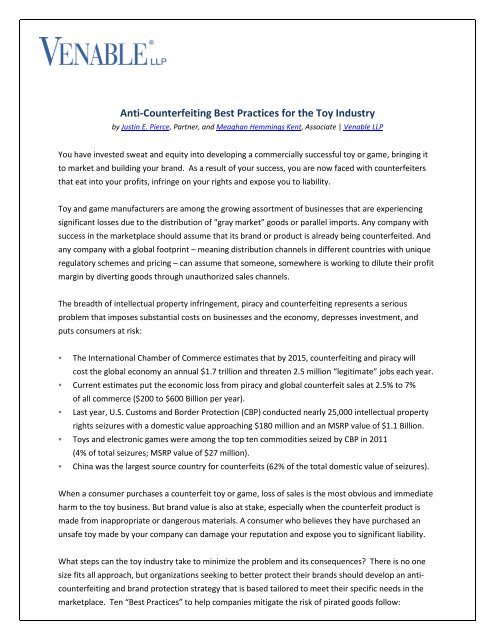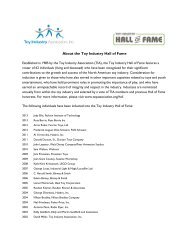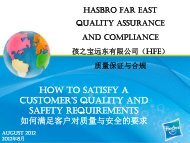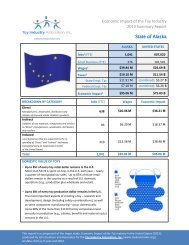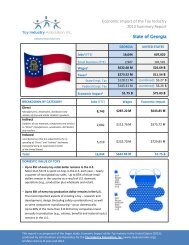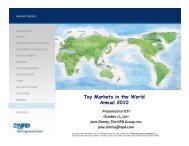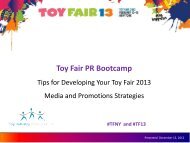Anti-Counterfeiting Best Practices for the Toy Industry
Anti-Counterfeiting Best Practices for the Toy Industry
Anti-Counterfeiting Best Practices for the Toy Industry
You also want an ePaper? Increase the reach of your titles
YUMPU automatically turns print PDFs into web optimized ePapers that Google loves.
<strong>Anti</strong>-<strong>Counterfeiting</strong> <strong>Best</strong> <strong>Practices</strong> <strong>for</strong> <strong>the</strong> <strong>Toy</strong> <strong>Industry</strong>by Justin E. Pierce, Partner, and Meaghan Hemmings Kent, Associate | Venable LLPYou have invested sweat and equity into developing a commercially successful toy or game, bringing itto market and building your brand. As a result of your success, you are now faced with counterfeitersthat eat into your profits, infringe on your rights and expose you to liability.<strong>Toy</strong> and game manufacturers are among <strong>the</strong> growing assortment of businesses that are experiencingsignificant losses due to <strong>the</strong> distribution of “gray market” goods or parallel imports. Any company withsuccess in <strong>the</strong> marketplace should assume that its brand or product is already being counterfeited. Andany company with a global footprint – meaning distribution channels in different countries with uniqueregulatory schemes and pricing – can assume that someone, somewhere is working to dilute <strong>the</strong>ir profitmargin by diverting goods through unauthorized sales channels.The breadth of intellectual property infringement, piracy and counterfeiting represents a seriousproblem that imposes substantial costs on businesses and <strong>the</strong> economy, depresses investment, andputs consumers at risk:• The International Chamber of Commerce estimates that by 2015, counterfeiting and piracy willcost <strong>the</strong> global economy an annual $1.7 trillion and threaten 2.5 million “legitimate” jobs each year.• Current estimates put <strong>the</strong> economic loss from piracy and global counterfeit sales at 2.5% to 7%of all commerce ($200 to $600 Billion per year).• Last year, U.S. Customs and Border Protection (CBP) conducted nearly 25,000 intellectual propertyrights seizures with a domestic value approaching $180 million and an MSRP value of $1.1 Billion.• <strong>Toy</strong>s and electronic games were among <strong>the</strong> top ten commodities seized by CBP in 2011(4% of total seizures; MSRP value of $27 million).• China was <strong>the</strong> largest source country <strong>for</strong> counterfeits (62% of <strong>the</strong> total domestic value of seizures).When a consumer purchases a counterfeit toy or game, loss of sales is <strong>the</strong> most obvious and immediateharm to <strong>the</strong> toy business. But brand value is also at stake, especially when <strong>the</strong> counterfeit product ismade from inappropriate or dangerous materials. A consumer who believes <strong>the</strong>y have purchased anunsafe toy made by your company can damage your reputation and expose you to significant liability.What steps can <strong>the</strong> toy industry take to minimize <strong>the</strong> problem and its consequences? There is no onesize fits all approach, but organizations seeking to better protect <strong>the</strong>ir brands should develop an anticounterfeitingand brand protection strategy that is based tailored to meet <strong>the</strong>ir specific needs in <strong>the</strong>marketplace. Ten “<strong>Best</strong> <strong>Practices</strong>” to help companies mitigate <strong>the</strong> risk of pirated goods follow:
1. Register key trademarks and trade dress in countries where your products are sold (or will be sold) andin countries where your products are manufactured or assembled. The U.S. Department of Commercesuccinctly advises that “<strong>the</strong> first step in protecting your business from intellectual property <strong>the</strong>ft is toprotect your IP – both in <strong>the</strong> United States and in o<strong>the</strong>r countries where you do business and source product.”(stopfakes.gov).2. Conduct an internal brand protection audit. This will assess how well your key brands and products aresecured in terms of legal protection, security measures, supply chain and distribution through authorizedversus unauthorized channels. The U.S. Department of Commerce advises: “Companies should inventory<strong>the</strong>ir IP. Examine your business to see what might be eligible <strong>for</strong> a patent, trademark, copyright or tradedress status.” (stopfakes.gov).3. Record key registered trademarks and trade dress with U.S. Customs & Border Protection (CBP). Onceyou have registered a copyright or a trademark with <strong>the</strong> USPTO, you may record your registration withU.S. Customs and Border Protection, which allows <strong>the</strong>m to identify, seize and destroy, infringing materials.4. Provide <strong>the</strong> CBP with in<strong>for</strong>mation on known or suspected distribution or import of counterfeits of yourproducts or <strong>the</strong>ir components. Regularly provide <strong>the</strong> CBP with updated product identification manualsand arrange <strong>for</strong> training sessions to educate inspectors on how to discern counterfeits from your au<strong>the</strong>nticgoods. Having a good relationship with U.S. Customs and providing <strong>the</strong>m with tips <strong>for</strong> spotting infringementsand counterfeits is crucial in ensuring that <strong>the</strong>y help you.5. Routinely monitor unauthorized use of your brands, and establish surveillance of your distribution channels.This can be done internally or through third party services.6. Select and use anti-counterfeiting technology. Be sure that it is: (a) appropriate <strong>for</strong> your product andbusiness model (e.g., radio-frequency identification tags, holograms, watermarks, covert markings or inks)and (b) not burdensome to use <strong>for</strong> product au<strong>the</strong>ntication.7. Educate employees and sales <strong>for</strong>ces about how critical IP protection is to <strong>the</strong> company’s success. Providetraining to employees and sales <strong>for</strong>ces to help <strong>the</strong>m better recognize and respond to counterfeiting issues.8. Seek out and hire experienced investigators to build en<strong>for</strong>ceable cases against networks that counterfeitor divert your goods. China, Hong Kong, India, Taiwan and Korea have been identified by U.S. Customs assignificant sources of counterfeit products, so be sure <strong>the</strong> investigators are capable of internationalsurveillance and have experience in those countries.9. Police <strong>the</strong> Internet and online marketplaces <strong>for</strong> sale of counterfeit goods. Make full and regular use of <strong>the</strong>procedures offered by e-commerce sites and online marketplaces to de-list or take down infringing listingsor websites.10. Work with experienced legal counsel. Be sure that <strong>the</strong>y are experienced in <strong>the</strong> handling and managementof intellectual property en<strong>for</strong>cement programs that reduce <strong>the</strong> impact of counterfeiting, product diversion,piracy or o<strong>the</strong>r infringing activities.Mr. Pierce will provide additional details on <strong>the</strong>se tenbest practices during an Aug. 21 webinar hosted by <strong>the</strong><strong>Toy</strong> <strong>Industry</strong> Association (TIA).


